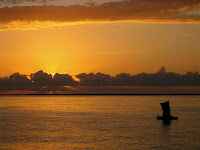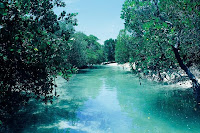Samosas by the sea by BV volunteers Alana & Rebecca
"Ah, farine" said the woman at the supermarket, scooping the half-kilo of flour Alana asked for into a plastic bag. We were picking up ingredients for our beloved fish samosas, the best street treats in town, and now we needed some oil. Neither the woman nor the man working there seemed to understand the word oil, so I picked up a bottle of olive oil in an attempt to explain what we needed. The woman walked over to a metal petrol barrel and there was the vegetable oil we were looking for. "Huile" she said, to which we responded "demi-litre?" After laughter and giggles, probably at Alana’s pronunciation, she grabbed a plastic water bottle, not cleaned from the contents it contained before, and started to funnel oil, dirt, ants, sand and all into it! Oh how they laughed at our attempt at gathering these ingredients – vazaha (the foreigners) do not cook here you know!
We then set off to find Angelo (one of our local staff) and his wife at their house on the beach. Down we walked from the supermarket (of sorts), winding our way through the straw and wood huts amidst goats, ducks, chickens and children – lots of children. We found him sitting on his bench outside, setting up an extremely out of place piece of culinary equipment – an old-fashioned metal pasta maker. He started to knead the flour and water (from an unknown source!) together in a tin bowl, rather more skilfully than either of us expected. After much working with the dough, he started to wind pieces of the dough through the pasta maker, forming ever-thinner sheets of dough, until we had reached a paper thin film which either Alana or I would have stuck our finger through in a second. We watched in awe at the grace and speed of his work, until his wife came along, shoved him aside and did everything twice as fast! He then went off to buy some snapper for the filling which he boiled and then scraped off the bone, all with his fingers of course. With a view of the waves rolling up on the pirogues in the background, we watched him mix in sakay (you really must try this if you love chilli!), salt (fresh from the marsh) and a small chopped red onion from his neighbour.
Finally ready (or allowed) to get involved, we started to put it all together. Alana and I each took a square of paper-thin dough, a scoop of the spicy fish mixture and started to fold the edges in to make our “perfectly triangular” samosas – well…practice makes perfect! All during this process, we were watched by a group of locals who were clearly bemused (or maybe amused!) by the 2 vazaha learning to cook. We then moved over to his “kitchen” which was a highly practical tin room, with a small door, even smaller window and decorative soot on the walls and ceiling! The oil had been heating over some burning logs and in went the samosas in batches of 3 or 4 at a time. Watching anxiously, Alana and I stood in the doorway (half dying from smoke inhalation) as Angelo fried them with the patience of a saint. We on the other hand, slightly less patient, had a quick taster of the cooler samosas while he carried on. Oh, and they were good, very good samosas! Probably the best (certainly the freshest!) we’ve had here in Andavadoaka.
15 samosas each later, we’d had our fill and decided to head back to camp - for lunch!






